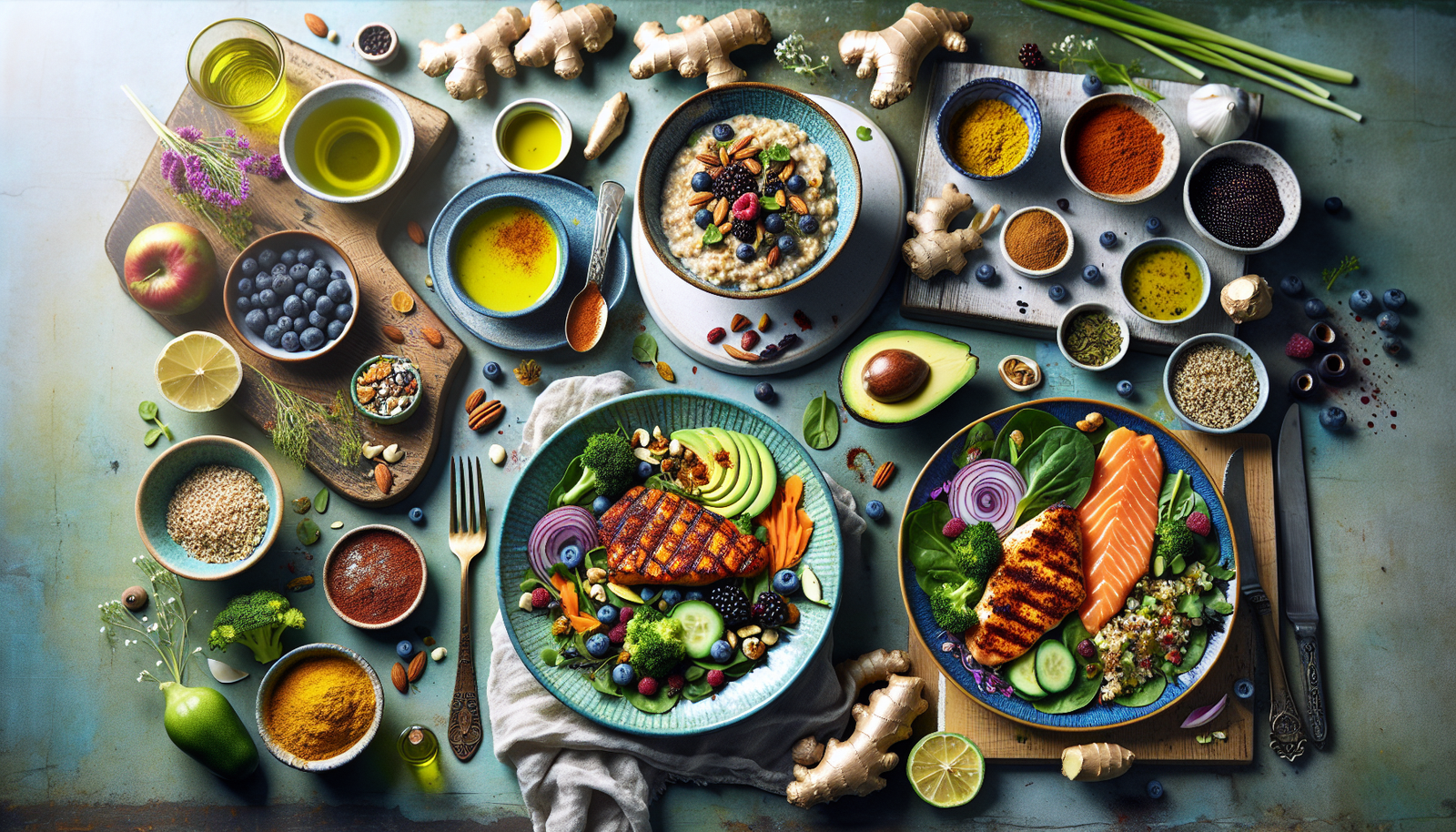
How to Add Anti-Inflammatory Foods to Every Meal
Add anti-inflammatory foods to your diet to help reduce chronic inflammation, which is linked to numerous health issues, including arthritis and heart disease. Studies show that certain dietary choices can significantly lower inflammation, enhancing overall well-being. This post will guide you on incorporating anti-inflammatory foods into every meal, from breakfast to dinner, ensuring a balanced and health-conscious approach. By learning how to seamlessly integrate these ingredients like turmeric, fatty fish, and leafy greens, you can transform your daily eating habits. Dive in to discover practical tips and simple recipes that make adding these powerful foods an enjoyable endeavor.
Understanding Anti-Inflammatory Diets
Anti-inflammatory diets are gaining attention for their potential health benefits. They focus on foods that fight inflammation, a common cause of various chronic diseases. But what makes a diet anti-inflammatory? Let’s dive in and explore the science, benefits, and common misconceptions.
The Science Behind Anti-Inflammatory Foods
Research shows that certain foods can reduce inflammation in the body. These foods typically include high levels of antioxidants, omega-3 fatty acids, and phytochemicals. Antioxidants combat oxidative stress, a key player in inflammation. Omega-3 fatty acids, found in fish and flaxseed, are known for their anti-inflammatory properties. Phytochemicals, present in fruits and vegetables, support the body’s natural defenses against inflammation.
For instance, turmeric contains curcumin, a compound with strong anti-inflammatory effects. Similarly, berries are rich in anthocyanins, which help reduce inflammation. The role of diet in managing inflammation is well-supported by scientific evidence, making it a valuable tool in maintaining health.
Benefits of Including Anti-Inflammatory Foods
Incorporating anti-inflammatory foods into your diet offers several health benefits. These foods can help manage and even prevent chronic conditions like heart disease, arthritis, and diabetes. They also support brain health, reducing the risk of cognitive decline and memory loss.
Eating an anti-inflammatory diet can improve mood and energy levels. This is because such foods promote healthy blood sugar levels and reduce systemic inflammation, which is often linked to fatigue and mood disorders. Additionally, these foods can aid in weight management by promoting a healthy metabolism.
Common Misconceptions About Anti-Inflammatory Diets
Despite their benefits, anti-inflammatory diets are often misunderstood. One common misconception is that they require strict adherence to a limited set of foods. In reality, these diets offer a wide variety of delicious and nutritious options.
Another misconception is that all dietary fats are inflammatory. While trans fats and excessive saturated fats can increase inflammation, healthy fats like those from avocados and nuts are beneficial. It’s important to focus on balance and choose whole, minimally processed foods.
Breakfast Ideas for Incorporating Anti-Inflammatory Foods
Kickstart your day with breakfast options that reduce inflammation. Mornings can be hectic, but incorporating anti-inflammatory foods into your breakfast doesn’t have to be difficult. Here are some ideas that are nutritious and quick to prepare.
Quick and Easy Anti-Inflammatory Smoothie Recipes
Smoothies are an excellent way to pack in nutrients. They can be made quickly and enjoyed on the go. Try blending spinach, frozen berries, and a banana with almond milk. Add a spoonful of chia seeds for their omega-3 content. Another option is a turmeric and ginger smoothie with pineapple and coconut water for a refreshing start.
Anti-Inflammatory Oatmeal Toppings
Oatmeal is a versatile breakfast base. Choose toppings that boost its anti-inflammatory power. Fresh berries, chopped nuts, and a sprinkle of cinnamon are tasty and beneficial. Consider adding a dollop of Greek yogurt for probiotics, which support gut health and reduce inflammation.
Delicious Anti-Inflammatory Breakfast Bowls
Breakfast bowls offer a hearty and satisfying meal. Start with a base of quinoa or buckwheat. Top it with avocado slices, poached eggs, and sautéed greens like kale or spinach. A drizzle of olive oil and a sprinkle of seeds can enhance the anti-inflammatory benefits.
Lunch and Dinner Anti-Inflammatory Meal Options
Lunch and dinner present opportunities to incorporate anti-inflammatory foods into your diet. With a little creativity, you can prepare meals that are both delicious and health-promoting. Explore these meal options for inspiration.
Creating Anti-Inflammatory Salads and Dressings
Salads are an easy way to include anti-inflammatory ingredients. Use mixed leafy greens, tomatoes, and cucumbers as a base. Add protein with grilled chicken or chickpeas. Dress with olive oil, lemon juice, and a pinch of turmeric for flavor and benefits.
Top Anti-Inflammatory Ingredients for Soups and Stews
Soups and stews are comforting and can be packed with anti-inflammatory ingredients. Consider using bone broth as a base, which contains collagen and amino acids beneficial for gut health. Add vegetables like carrots, celery, and garlic, along with herbs such as ginger and turmeric, to enhance flavor and nutritional value.
Grilled and Roasted Anti-Inflammatory Vegetable Recipes
Grilled and roasted vegetables are a tasty way to enjoy anti-inflammatory foods. Try roasting Brussels sprouts, sweet potatoes, and bell peppers with a touch of olive oil and herbs. Grilling asparagus or zucchini can add a smoky flavor and pleasing texture to your meals.
Snacks and Desserts with Anti-Inflammatory Benefits
Snacking and dessert time can also be opportunities to enjoy anti-inflammatory foods. These options are both satisfying and health-focused, helping you to stay on track without feeling deprived.
Nutritious Anti-Inflammatory Snack Ideas
For a quick snack, try a handful of raw almonds or walnuts. They provide healthy fats and antioxidants. Fresh fruit like apples or oranges paired with a bit of nut butter can also be a satisfying option. Consider a small bowl of mixed berries for a sweet yet nutritious treat.
Crafting Anti-Inflammatory Desserts
Healthy desserts can still satisfy your sweet tooth. Make a chia pudding using coconut milk and vanilla extract, topping it with fresh mango slices. Dark chocolate with a high cocoa content is another option, as it’s rich in antioxidants. Just a small piece can be both indulgent and beneficial.
Best Anti-Inflammatory Teas and Beverages
Herbal teas can complement your diet with anti-inflammatory benefits. Brew ginger tea for its soothing properties. Green tea is another excellent choice, known for its powerful antioxidants. For a refreshing alternative, try infused water with slices of cucumber and mint.
“`
Conclusion
The article highlights the importance of incorporating anti-inflammatory foods into one’s diet to reduce inflammation and improve overall health. It suggests including foods rich in omega-3 fatty acids, such as fatty fish, flaxseeds, and walnuts. Berries, like blueberries and strawberries, are recommended for their antioxidant properties. The article advises opting for leafy greens, like spinach and kale, for their high levels of vitamins and minerals. Spices like turmeric and ginger are emphasized for their natural anti-inflammatory effects.
FAQ
What are the best anti-inflammatory foods to incorporate into my diet?
Incorporating foods like leafy greens, berries, nuts, and fatty fish can significantly reduce inflammation. These foods are rich in antioxidants and omega-3 fatty acids, which help fight inflammation naturally.
How do anti-inflammatory foods help in reducing chronic inflammation?
Anti-inflammatory foods supply essential nutrients that combat inflammation at the cellular level. They work by reducing the production of inflammatory compounds and supporting the immune system.
Are there specific anti-inflammatory foods recommended for arthritis relief?
Foods such as turmeric, ginger, and olive oil are highly recommended for arthritis relief. They possess natural compounds that can help alleviate joint pain and swelling.
What are the top natural sources of anti-inflammatory omega-3 fatty acids?
Fatty fish like salmon, mackerel, and sardines are excellent sources of omega-3s. Flaxseeds and walnuts also provide plant-based omega-3s, making them great additions to your diet.
How can I create a meal plan focused on anti-inflammatory ingredients?
Start by including a variety of colorful vegetables, lean proteins, and healthy fats in your meals. Focus on whole foods and reduce processed items to maintain an anti-inflammatory diet.
Can anti-inflammatory foods assist in managing autoimmune diseases?
Yes, these foods can help manage autoimmune diseases by reducing systemic inflammation. A diet rich in anti-inflammatory ingredients supports the immune system and may alleviate symptoms.











